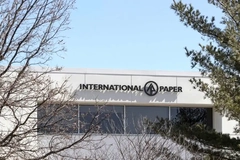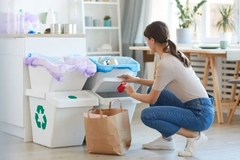Cutting carbon emissions in the “decade of action”: Packagers unveil key reduction strategies and challenges

02 Aug 2023 --- Carbon reduction lies at the heart of the packaging industry’s efforts to improve environmental sustainability. Carbon capture technologies, carbon-reduced material development and carbon labeling on products are some of the most prominent methods the industry is using to lower emissions and help consumers reduce their footprint through purchases.
Through international agreements like the Kyoto Protocol and Paris Climate Agreement, governments have pledged to drive down CO2 emissions to achieve carbon neutrality. But according to the Council of Foreign Relations, global energy-related CO2 emissions grew by 0.9% or 321 metric tons in 2022, reaching a new high of over 36.8 gigatons.
We speak to packaging experts from Huhtamaki, Tetra Pak and Mosca to learn about the latest innovations, challenges and opportunities the industry is undergoing to drive down CO2 rates.
We discuss the emergence of bio-based polymers, the viability of increased recycling, the transition to fiber-based materials and how governments can aid businesses through infrastructural development and policy changes.
 Boosting recycling is only one part of achieving carbon emissions reductions, says Tetra Pak.Circularization against carbon pollution
Boosting recycling is only one part of achieving carbon emissions reductions, says Tetra Pak.Circularization against carbon pollution
Dr. Paul Collins, vice president of sustainability at Huhtamaki, tells Packaging Insights the company is implementing a number of strategies, including optimizing energy, water and waste usage to achieve its ambition of being carbon-neutral by 2030.
“We are driving the transition to a carbon-neutral and circular economy by using renewable, natural resources, focusing on waste management, ensuring our products are recyclable, compostable or reusable and minimizing our environmental footprint across the value chain by focusing on designing for circularity and promoting sustainable end-of-use for packaging,” he says.
Huhtamaki’s science-based targets include sourcing 100% of renewable electricity and carbon-neutral production by 2030.
“During past years, we have acted to significantly increase the use of renewable energy and developed water management plans for all of our factories.”
“Another important step toward carbon-neutral production was signing our second Virtual Power Purchasing Agreement (VPPA) in the US, covering approximately 25% of our electricity usage in North America,” Collins continues.
“This is in addition to the VPPA we signed in 2021, which will cover approximately 80% of our energy use in Europe and will come online in 2024. In renewable energy, in addition to the current 80% coverage in Europe, we gained 30% coverage for carbon-neutral energy in North America through our second VPPA.”
Bio-based transitions, machinery upgrades
Witold Nowak, group director for global purchasing and procurement at Mosca, emphasizes that while recycling plays an important role in circularizing packaging materials, switching to bio-based polymers is essential in reducing reliance on fossil fuel-based resources and the associated carbon emissions.
“While we have managed to increase our ratio of recycled to virgin (fossil) materials over the past years, a further reduction would require the switch to bio-based polymers. At the current time, these materials are more expensive to produce – and it’s doubtful that the market would accept the resulting increase in price,” he says.  Witold Nowak, group director global purchasing and procurement at Mosca.
Witold Nowak, group director global purchasing and procurement at Mosca.
“We are convinced, however, that bio-based consumables will become commercially viable in the near future.”
On the machinery side, Mosca is implementing more IoT modules to enable its customers to upgrade their maintenance concepts to predictive models, Nowak explains. “This will help make our machines and their parts even more long-lasting and sustainable.”
The company’s new TechCenter also allows customers to analyze their loads and respective packaging and load-securing concepts.
“Our goal here is to find the perfect balance between product securement and minimum use of strapping and wrapping material. On top of that, our newly developed CO2 product calculator provides the exact emission data for the specific packaging. We consider ourselves consultants on our customers’ path to a high level of sustainability in their end-of-line packaging processes,” says Nowak.
Breaking barriers in fiber-based packs
Gilles Tisserand, vice president of climate and biodiversity at Tetra Pak, highlights that securing food security is the principal purpose of creating effective packaging.
 Examples of Huhtamaki’s recyclable and monomaterial packaging designs.He notes that hidden costs amounting to US$12 trillion each year are produced by the F&B sector yearly. “They are the single largest driver of the biodiversity crisis, while failing to adequately deliver the healthy diets and nutrition the world needs, as roughly 821 million people are chronically undernourished.”
Examples of Huhtamaki’s recyclable and monomaterial packaging designs.He notes that hidden costs amounting to US$12 trillion each year are produced by the F&B sector yearly. “They are the single largest driver of the biodiversity crisis, while failing to adequately deliver the healthy diets and nutrition the world needs, as roughly 821 million people are chronically undernourished.”
“To ensure that we can sustainably meet the needs of our current and future populations while contributing effectively to the objectives of the Paris Agreement, we need to transform the food systems. Collectively reinventing how we source, produce and process our food, its transportation, and the materials we use to package it is really a monumental task,” Tisserand says.
“If you wonder about the size of the task, look no further than Scope 3 emissions. At Tetra Pak, they represent 99% of our value chain impact. However, when considering Scopes 1, 2 and 3 altogether, we have reduced these emissions by over 20% since 2010. That’s why we strongly believe that the food processing and packaging industry can play a critical role in driving carbon down at every step of the food systems.”
Aseptic packaging
Tisserand explains that aseptic beverage cartons score better from a climate-impact perspective when compared to other packaging options for perishable liquid foods. This is due to their high share of renewable materials – approximately 70% paperboard.
“They are designed for recycling and are recyclable wherever the necessary infrastructure exists. This is the case in the EU, which has a more than 50% collection for recycling rate,” he says.
“But the picture is very fragmented across the globe and long-lasting change can only happen through collective action, transformational innovation and bold investments.”
 Gilles Tisserand, vice president of climate and biodiversity at Tetra Pak.Tetra Pak says it is currently working to create the world’s most sustainable food package: A carton that is solely made of renewable or recycled materials, is fully recyclable and carbon neutral.
Gilles Tisserand, vice president of climate and biodiversity at Tetra Pak.Tetra Pak says it is currently working to create the world’s most sustainable food package: A carton that is solely made of renewable or recycled materials, is fully recyclable and carbon neutral.
“We are investing €100 million (US$109) per year and will continue to do so over the next five to ten years to further enhance the environmental profile of food cartons because the cost of inaction on sustainability today is a world we won’t recognize tomorrow,” says Tisserand.
The company is also testing a fiber-based barrier to replace the aluminum foil layer currently used in aseptic beverage cartons. Although thinner than a human hair, the aluminum layer is responsible for about a third of the GHG emissions linked to Tetra Pak’s base materials.
A pilot batch of single-serve packs featuring this industry-first material has been put on shelf for a commercial consumer test last year, with a larger technology validation expected in the upcoming months, says Tisserand.
Policy changes
Beyond R&D, the packaging industry also continues to call for help from policymakers on the national and international levels.
“Since taxation for excessive carbon emissions in packaging is already being implemented, granting subsidies to carbon reduction efforts would support the reduction efforts even further. Subsidizing circularity initiatives, dematerialization developments and environmentally friendly materials would help them gain traction and become more attractive for the entire industry,” says Nowak.
Tisserand notes that the UN has called this “a decade of action” – meaning all actors are expected to make improvements – both public and private.
“We see regulatory developments pushing toward circularity and food system decarbonization while aiming to reduce waste and litter. The EU proposal for a Packaging and Packaging Waste Regulation is a recent example of how governmental policy is stimulating corporate action,” he concludes.
By Louis Gore-Langton











